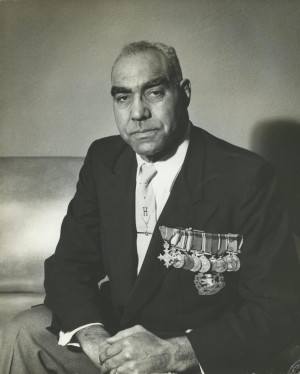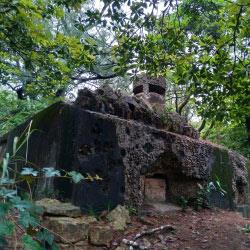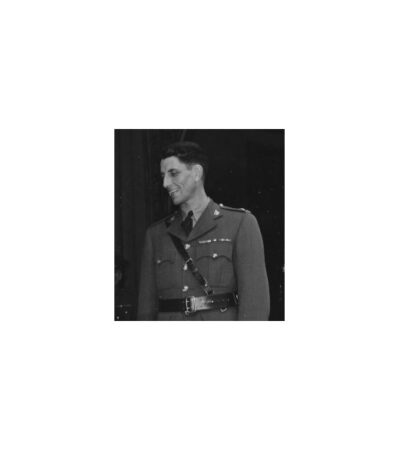The 48th Highlanders were among the first Canadian units to see battle during the Second World War. They landed in Sicily in July 1943 as part of the 1st Canadian Infantry Division. They engaged in nearly continuous fighting until their last major battle of the Italian campaign: the crossing of the Lamone River in December 1944. They would move to the Ravenna marshes area in February 1945, and then travel through France in March to link up with the Canadian soldiers who had landed in Normandy and fought their way through the Channel ports and the Scheldt Estuary. By mid-April, Canada’s two Corps were together and poised to liberate the Kingdom of the Netherlands.
The 48th Highlanders were part of Operation CANNONSHOT, the operation to cross the Ijssel River and free the city of Apeldoorn. In broad strokes, the 2nd Canadian Corps would advance first. They proceeded north and east, with the Ijssel River on its western flank. With the eastern side of the Ijssel River secured, the 1st Canadian Infantry Division would cross the river and advance towards Apeldoorn. Next, the 1st Canadian Corps would attack north and west, first seizing the city of Arnhem in Operation ANGER and then driving northwards rapidly as part of Operation CLEANSER. The German defenders in Apeldoorn would find themselves in a closing trap.
Liberating Apeldoorn (April 16-17)
When the sun came up the next day, the 48th Highlanders found themselves in a precarious position. Germans on the west side of the canal fired machine guns and sniper rifles at them when they passed through open areas, and German artillery had not yet been silenced. Private Robert Hyson was killed by artillery along the canal; Captain Murdock wrote to Hyson’s wife in England, “You have lost a fine husband, and we in the company have lost a good friend.” At the same time, Germans on the east side of the canal were now trapped and had no intention of surrendering. Counsell and the 48th spent the day carefully mopping up German positions on the east side of the canal.
Typhoons from the Royal Air Force attacked German positions on the west side of the canal later in the day, and Royal Canadian Engineers began constructing a bridge at the canal lock. The 48th prepared to cross the canal, but Brigadier “Des” Smith changed his plan. The Royal Canadian Regiment moved into the 48th Highlanders’ old positions; the Highlanders would move two miles back and prepare to enter the city further north. Meanwhile, the Canadian artillery was being repositioned to support the canal crossing operation. The firepower was necessary to support the attack and would have almost certainly destroyed much of the historic city.
While the 1st Canadian Infantry Division prepared to cross the canal, the 5th Canadian Armoured Division attack to the west of Apeldoorn (Operation CLEANSER) put the German defenders in a predicament. The Germans would soon be surrounded if they did not withdraw quickly. They quietly departed their positions under the cover of darkness on April 16. The Canadians only learned that they had left when a Dutch resistance fighter, Gijs Numan, came across the canal and passed on the news. The soldiers of the Royal Canadian Regiment were understandably skeptical. They were convinced when Numan returned with some captured German soldiers. Apeldoorn was spared the devastating offensive.
The 48th Highlanders crossed the canal and entered northern Apeldoorn the next day. There was little time for celebrating, and they immediately transitioned to the rapid pursuit of fleeing German forces, sending a flying column under command of Major Beal, 70 miles in under five hours to Harderwijk to link up with the 5th Canadian Armoured Division. With the Germans facing entrapment, the German commander, Generaloberst Johannes Blaskowitz threatened to flood the Netherlands. The two forces agreed to a temporary truce that allowed food to be rushed to the starving Dutch people. On May 5, Blaskowitz surrendered to Canadian Lieutenant-General Charles Foulkes in Wageningen.
At War’s End
The 48th Highlanders lost eighteen soldiers during Operation CANNONSHOT. As they fell, their bodies were taken to the rear to be buried. Captain Alex Rapson, the unit padre, found a suitable site at the dyke that protected the town of Wilp from the floodwaters of the Ijssel River. One by one, work parties brought the bodies to this dyke, and they were buried in a row at the top. White crosses marked each grave, to which the villagers of Wilp added an impressive array of flowers. Rapson wrote that each grave had four clusters of red and white lilies, and pansies were planted in a ring around the graves. The cut flowers included white and purple lilacs, as well as red, yellow, orange, and white tulips; “the white crosses seemed to rise out of a lovely sea of flowers.”
With the end of the war just days away, James Counsell (now promoted to lieutenant-colonel), and three officers, the company sergeant major, four sergeants, and fifteen troops from each company, returned to Wilp to hold a memorial service. The attendees were amazed to see how well the locals took care of the graves. Sixty people from Wilp attended the service, and a clergyman from the town asked to speak. He promised that they would care for the graves in perpetuity. The bodies were later moved to the Holten Canadian War Cemetery. Dutch children still lay flowers on the graves in Holten, and the people of Wilp still honour the site where the bodies were once buried.

The 48th Highlanders Roll of Honour from Operation CANNONSHOT
ARMSTRONG, Corporal, GEORGE R. Age 30. Son of John and Mary A. Armstrong, of Newcastle-on-Tyne, England.
AUBRY, Private, ROLAND. Age 20. Son of Stanislas and Blanche Aubry, of Sturgeon Falls, Ontario.
CASS, Private, GORDON HENRY CHARLES. Age 21. Son of Harry and Ruby Cass, of Toronto, Ontario.
CONNELLY, Private, LEONARD OLIVER. Age 18. Son of James Frederick and Louise Mary Connelly, of Sudbury, Ontario.
DUCHARME, Private, JAMES. Age 22. Son of Pascal and Virginia Ducharme, of The Pas, Manitoba.
GAYNER, Private, JORDAN W. Age 24. Son of Albert (deceased) and Ethel Gayner, of Toronto, Ontario.
GUNTER, Private, BERTON CHARLES. Age 27. Son of Robert and Ethel Gunter, of Toronto, Ontario.
HARRIS, Private, FRANK. Age 27. Son of Allan and Margaret Harris; husband of Ilene Harris, of Oakville, Ontario.
HYSON, Private, RONALD V. Age 24. Son of Kempton and Grace Hyson, of Bridgetown, Annapolis Co., Nova Scotia; husband of Kathleen Hyson.
IRONS, Private, GEORGE BRADLEY. Age 36. Son of Wesley and Elizabeth Irons, of Curve Lake, Ontario.
JAMIESON, Private, ROBERT. Age 21. Son of Robert and Jane Hamilton Jamieson, of Milner, British Columbia.
JONES, Private, GEORGE ALEXANDER. Age 26. Son of George (deceased) and Mable Jones of Gravenhurst, Ontario; husband of Stephanie Marie Jones, of Hamilton, Ontario.
MACKENZIE, Lieutenant-Colonel, DONALD ALEXANDER. Age 30. Son of Kenneth (deceased) and Marguerette Mackenzie, of Owen Sound, Ontario; husband of Mary Louise Mackenzie and father of Louise Mackenzie, of Toronto, Ontario.
McCUTCHEON, Captain, HAROLD JAMES. Age 35. Son of Norman and May McCutcheon of Toronto, Ontario; husband of Ruth Ann McCutcheon and father of Richard and William McCutcheon.
OLIVIER, Private, RONALD. Age 20. Son of Paul and Elvira Olivier, of Montreal, Quebec.
POPE, Private, HARRY DOUGLAS. Age 21. Son of Harold and Evelyn Lucy May Pope, of Toronto, Ontario.
STAUGHTON, Private, WILLIAM JOHN EDWARD. Age 19. Son of William S. and Katie Staughton, of Toronto, Ontario.
TOWNSON, Corporal, JAMES L. Age 25. Son of George and Ellen Louisa Townson; husband of Bernice Norma Townson and father of Jimmie Townson, of Toronto, Ontario.
WILLIAMS, Lieutenant, JOHN FREDERICK. Age 29. Son of John H. and Annie Williams, of Peterborough, Ontario.
Note that Private Steven J. Motkaluk, died 2 May 1945, also lies buried at the Holten Canadian War Cemetery. He died in a German prisoner of war camp and was subsequently reinterred.
Article written by Tyler D. Wentzell for Honouring Bravery





